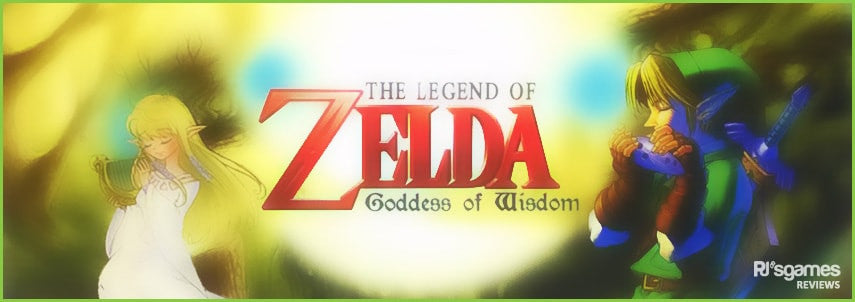The Legend of Zelda: Goddess of Wisdom was released in 2010 and is an unofficial game in the Legend of Zelda series; it was co-developed by Omega and SePH, however, the game was fully debugged by Puzzledude. SePH had previously created the Legend of Zelda: Parallel Words fangame and their experience with ROM hacks certainly made developing Goddess of Wisdom a smoother process.
Various versions of this game exist online, and older versions of the game can also be found; these versions are not the 'completed' game as they still contain bugs that were removed by the debugging team. The game had several debuggers, and only the version worked on by Puzzledude is the complete game. Other versions of the game cannot be completed as they contain game-breaking bugs that prevent progress.
Goddess of Wisdom features an entirely new story and seems to be set in a different timeline which has provided the developers with a lot of freedom for the plot. The game begins with Link's Uncle racing to save Princess Zelda who was captured by the Council of Wizards; as expected, things go awry, and Link must save Zelda himself.
As the game continues, it becomes clear why the Council kidnapped Zelda and Link is the only one who can save the world from the horror that's about to be unleashed. The Wizards have also stolen the Crystal of Wisdom shattered it and spread the pieces to their members in preparation for their plans to pass. It's a classic Legend of Zelda style story and considering the Council of Wizards is looking to take over the world, it's not surprising that Ganondorf is somehow involved.
There is nothing too special about the plot in this game but it certainly fits in with the style of the official Legend of Zelda games; it was created as a hack for The Legend of Zelda: A Link to the Past and the start of the game is very close to the plot of the original.
Plot enthusiasts shouldn't expect an amazing story that explains anything from the series, but this is still an entertaining story. There are side quests in the game, but most of them are hidden and are not very obvious. While there are some side quests, there's a lot less to do in this game.

Considering this game was created as a ROM hack, it's not surprising that Goddess of Wisdom follows the classic gameplay style seen in the official games. Players need to travel through the Hyrule overworld as they search for the pieces of Crystal of Wisdom and fight to stop the Council of Wizards.
It follows the classic Action-Adventure style seen in the main series where the player takes control of Link as he fights his way through Hyrule; this is done from the overworld map which is used to navigate through the different zones. There are plenty of areas for the player to explore and almost all of these zones are from the official games.
While the game does include a lot of locations from the official games, it also includes a unique puzzle mechanic, statue puzzles, which was added by the developers. These statue puzzles are relatively simple to understand but can seem to be very complicated at first. Some zones will require the player to place a statue on a weight-activated panel to open a door so that the player can progress through the game. Despite this being an entirely new mechanic to the Legend of Zelda, there are no instructions on how the puzzle works and players are left to work this out on their own. Statues need to be pushed and dragged into place by carefully manipulating statues around the different zones; most puzzles require the player to move the statue to a different room through a tight corridor.
The statue mechanic adds an interesting puzzle element to the game which makes this game stand out slightly from the others; the mechanic is relatively limited in this game, however, and the developers could have expanded on this a little more. Goddess of Wisdom is still focused on the classic Action-Adventure gameplay which makes these short puzzles segments a nice change of pace.
Players should expect to see a few new areas in this game with a variety of unique new dungeons that suit the Legend of Zelda series nicely; these dungeons are relatively straightforward to navigate despite the lack of a map or compass. At points, some of them can become confusing, mostly due to them lacking consistent levels.
As to be expected from a Legend of Zelda game, the player collects more items as the game progresses; most of these items should be familiar to fans of the series. The items are used in some rather creative ways which can be quite unexpected but certainly entertaining. Most items are included in the Goddess of Wisdom ROM hack which is nice to see. However, some armor and equipment upgrades seem to be missing from the game.
Fans of the Legend of Zelda will find combat in this game very familiar; it matches the classic combat gameplay from the games in the official series. The game is played in a bird-eye view of an overworld styled map and enemies can be found in most of the zones, enemies will attack the player if they get too close which means they can be avoided.
Link wields his trusty sword from the start of the game, and more pieces of equipment become unlocked as the game progresses; as expected, he picks up the bow and shield near the beginning of the game. Upgrades are collected throughout as the player discovers new items found in different zones, some of these are hidden and are harder to find. Once the item has been collected, the player can access it in their inventory.
Light attacks from the sword deal a small amount of damage, but the player can also use a more powerful Spin Attack which is taught to Link by his Uncle; these are his primary forms of attack but the player can also use a bow. The bow can be used to stop certain turrets from firing and for attacking enemies over a longer distance. Using the shield is slightly different; it's strapped to the players back and is used to deflect oncoming projectiles. To do this effectively, Link needs to turn so that it hits the shield on his back which prevents him from taking damage.
There are a variety of enemies in the game which increase in difficulty as the game progresses; the bosses in the game are the same as the ones from “A Link to the Past” with some slight changes to increase the difficulty.
Goddess of Wisdom has no major combat changes over the original “A Link to the Past” game is was created from; it makes the game feel very familiar but could also make it tedious to play at times.
The player starts the game with a low number of heart points, and once they run out of these points, the player will die; death in the game has very little effect however as Link is respawned exactly where he died.
Unlike some other Legend of Zelda ROM hacks, this isn't a particularly difficult game. The difficulty is slowly raised as the game progresses and the enemies at the start of the game are not especially difficult. Despite this, the limited health points can make the game feel quite difficult at the beginning of the game and could seem a little off-putting for some players. This does become balanced as the game progresses, so it's not a major issue.
As to be expected, the puzzles also become harder as the story progresses. Exploring the world can be frustrating at times as there is no clear map of where the player needs to go, dungeons, in particular, can feel tedious when locating items or new doors.
The graphics in Goddess of Wisdom have been upgraded from A Link to the Past with new graphics for the foliage; Link has also been given a make-over. As to be expected, the game has also been given a unique title menu which was created by the developers. These changes are quite small but stand out enough to make them noticeable.
It features the classic overworld map style seen in the original game with very few changes being made; some graphical changes have been made to the pressure activated pads and statues to help them stand out slightly more to the players, but there have been no significant changes.
Like with most other fan games, Goddess of Wisdom uses the music from the original A Link to the Past game which makes sense considering this is a ROM hack. The music and audio are mostly taken from the original game which suits the atmosphere of Goddess of Wisdom but does mean that the game lacks original content in this area.
Several versions of Goddess of Wisdom exist, and most of these do contain bugs; the earlier versions of the game are riddled with severe game-breaking bugs and glitches that prevent players from progressing through it.
The final version of the game is the one that was worked on by Puzzledude who completely debugged the game and made 100% story completion possible. This is the version that the review is based on and the one that is available on PJ's Games.
Only one especially noticeable bug is still in the game, but this has no real impact on progressing through the game which makes it more of a minor annoyance than a real issue. There's a point in the game where the player can fall into a hole in a dungeon with the Red Cane item; it causes a minor graphical glitch which is easily fixed by leaving the dungeon. After leaving to fix the issue, the player can re-enter the dungeon without issue.
Legend of Zelda: Goddess of Wisdom certainly feels like a ROM hack, it may feature a different story, but this is certainly a modified version of Legend of Zelda: A Link to the Past. The game looks slightly different but anyone playing the first hour of the game could easily confuse this for the original game.
The story unfolds in a somewhat different way to the original game, but it still follows the classic story style of Legend of Zelda; the game looks and feels exactly like a classic Legend of Zelda game which makes this a great alternative to the original without compromising on quality. There are no major bugs that damage progress through the game and it's still possible to complete dungeons if the graphical glitch occurs.
The statue puzzles make the game more entertaining at some points and require the player to use a little strategy while maneuvering them; some of these puzzles are very long, however, and it's easy to get them wrong which can make them very frustrating at times.
Overall, this is a solid game for fans looking to play a new Legend of Zelda game for the classic gameplay that gamers love; the story, however, is average so it doesn't stand out in that respect.
Pros:
+ Interesting statue puzzle mechanics
+ Good difficulty level
+ Dungeons are well-balanced
Cons:
- Story could be more compelling
- Minor graphical bug
- Start of the game is difficult






3 comments
Lex
You have to press the X button a few times to open up the map.
Luna
Hey there, we haven’t heard of any problems using the map. If you’re playing the version we sell here you should be fine. If you’re playing a ROM please make sure it is patched correctly otherwise you might experience glitches.
Luda
Have a question. I have Zelda Goddess of Wisdom SNES but when I open the map only half of the map is seen. Do I have to discover the rest of the map? Is this a glitch or maybe bug? Where’s the rest of the map? Completed all I can and now stuck since the bottom half of the map is not there.